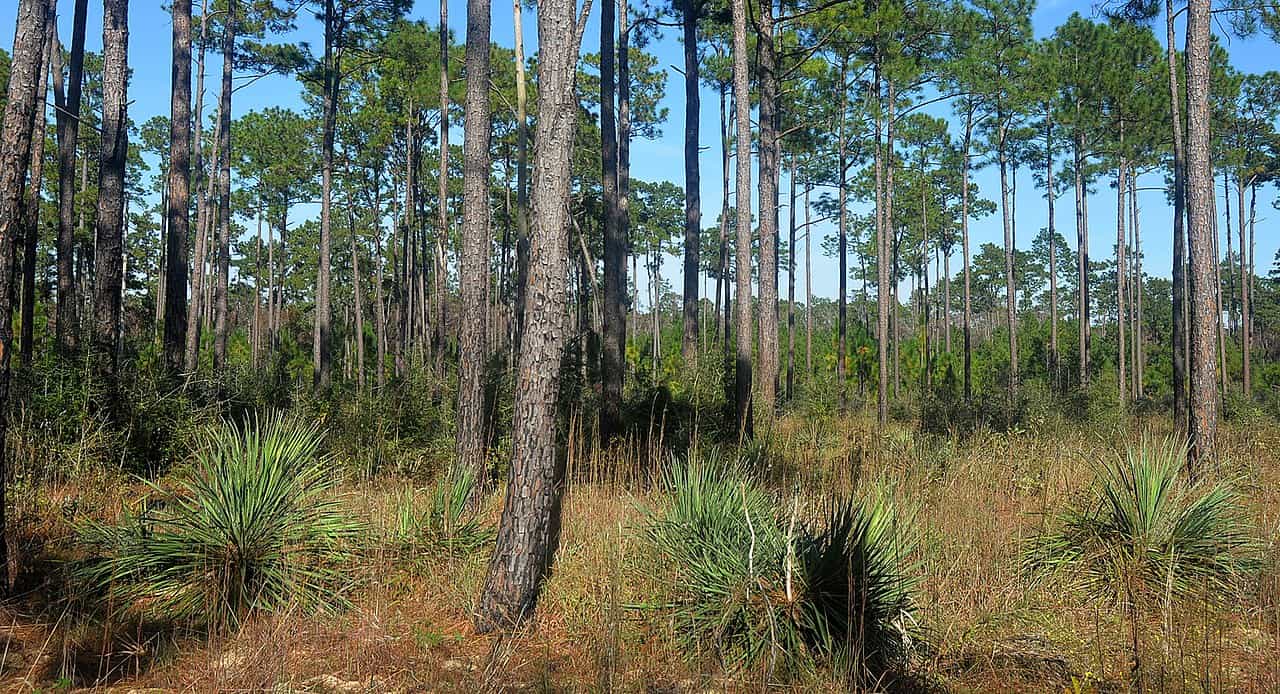In Louisiana, Driskill Mountain is the highest point in the whole state. But as far as mountains go, it’s pretty tiny. Driskill Mountain is only about 535 feet (163 meters) above sea level. To put that into perspective, Driskill Mountain is just a little bit taller than a football field’s length.
Despite its size, this hill-sized mountain is still popular with people who enjoy being outside and exploring nature. This spot is teeming with wildlife, and you can see several plants and animals on your hike. This article will help you plan the perfect wildlife trek in Louisiana!
Wildlife Thriving atop Louisiana’s Peak
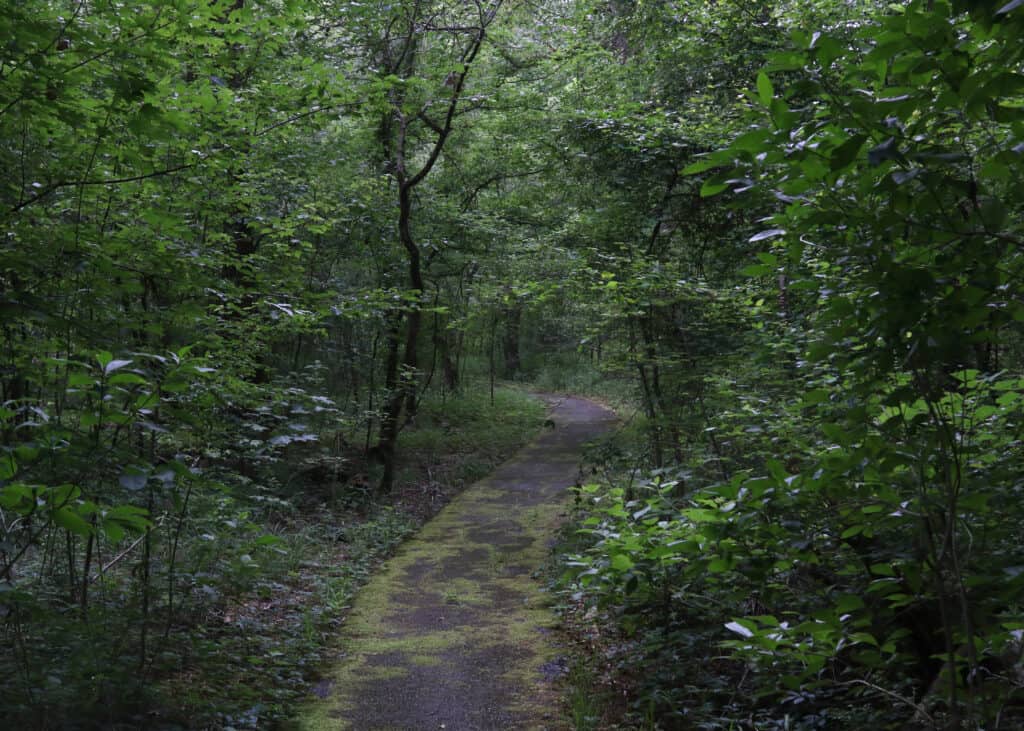
Driskill Mountain is popular with people who enjoy being outside and exploring nature.
©iStock.com/Nancy Strohm
Driskill Mountain is packed with cool creatures that make this place their home. The following animals are just some of the awesome wildlife you can find here:
- Big Brown Bat
- Black Snakes
- Black Bear
- Bobcats
- Coral Snakes
- Foxes
- Gopher Tortoise
- Long Tailed Weasel
- Northern Long-Eared Bat
- Quail
- Red-Tailed Hawks
- Squirrels
- Spiders
- Eastern Wild Turkeys
- Wolves
As you can see, many different critters are running around Louisiana’s tallest mountain!
Wild Turkey Sightings
Louisiana Department of Wildlife and Fisheries is asking for help from hunters, landowners, and outdoor enthusiasts to participate in a special survey called the Wild Turkey Population Survey. This survey helps gather information about how many wild turkeys there are in the state and how well they reproduce. So, if you spot any wild turkeys, don’t forget to share your observations through the turkey survey here.
Discovering Wildlife near Driskill Mountain
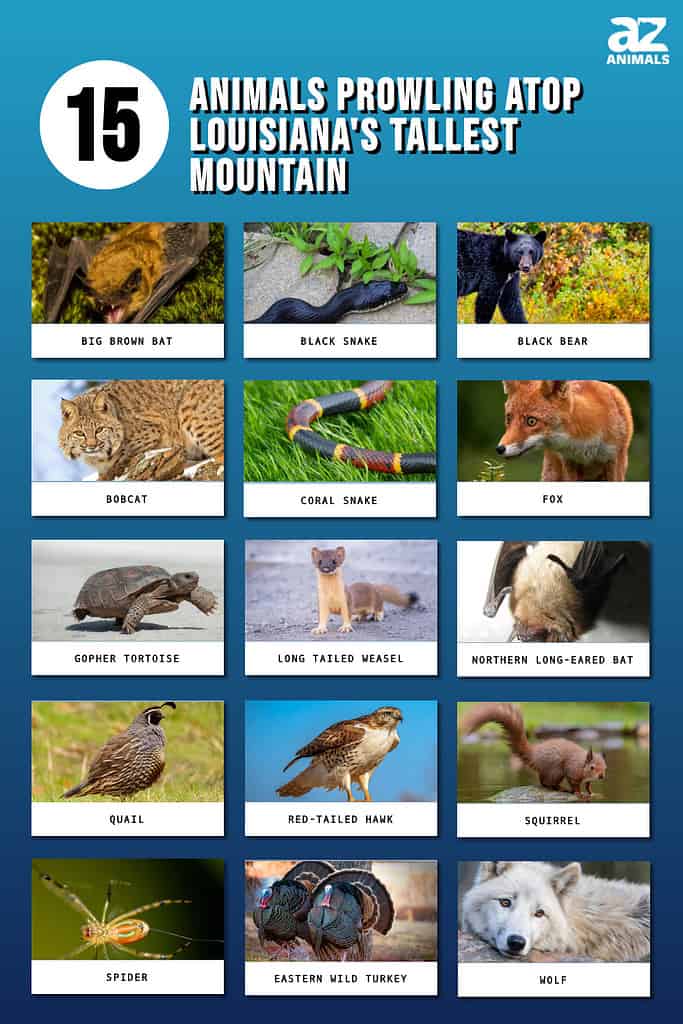
Do you have a favorite animal you’re hoping to spot on your hike? Let’s take a closer look at each of these animals and when you’re most likely to see them around Driskill Mountain.
1. Big Brown Bat

The big brown bat is active at night, so sightings on Driskill Mountain can be rare.
©Jay Ondreicka/Shutterstock.com
Big brown bats are medium-sized bats with brown fur and large ears. They are active at night, using echolocation to navigate and hunt for insects. Look for bats taking off to the skies as the sun goes down.
2. Black Snake
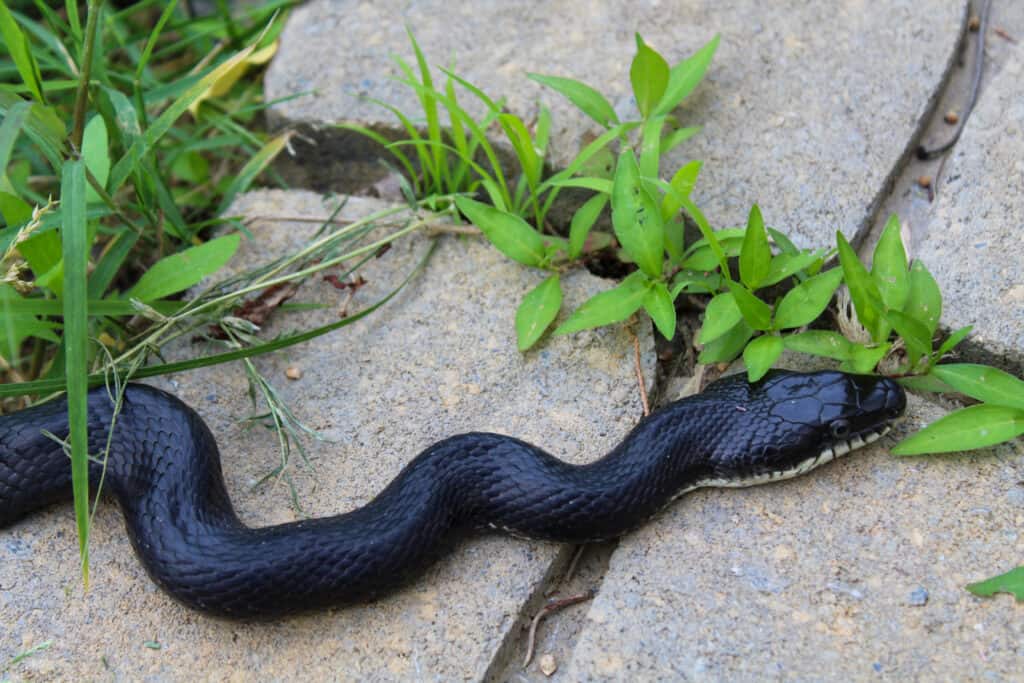
Non-venomous black snakes slither in the wilds of Louisiana.
©ButtermilkgirlVirginia/Shutterstock.com
Sleek and non-venomous, black snakes have shiny dark scales that help them blend in. These daytime hunters are often seen slithering through the undergrowth in search of rodents and birds. You’ll see them sunning themselves along the trail if you’re lucky.
3. Black Bear
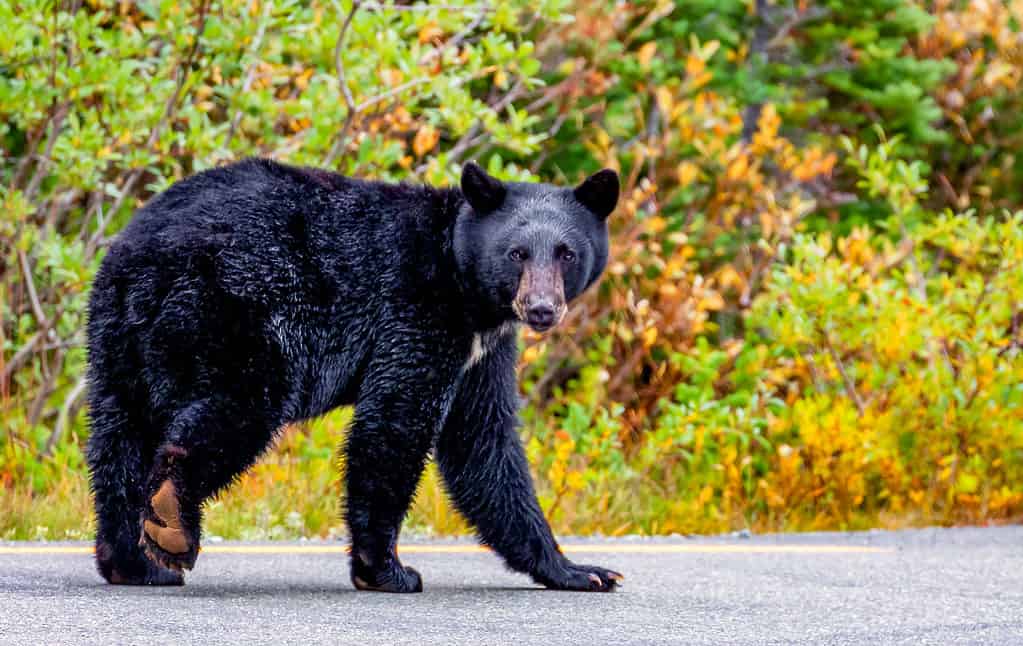
The black bear is one of the largest mammals inhabiting the mountains of Louisiana.
©iStock.com/Mark Lee
Majestic and powerful, black bears are large creatures with black or brown fur. They’re one of the biggest mammals in Louisiana. Bears are primarily active during dusk and dawn, foraging for food like berries, nuts, and occasionally small mammals or fish.
4. Bobcats
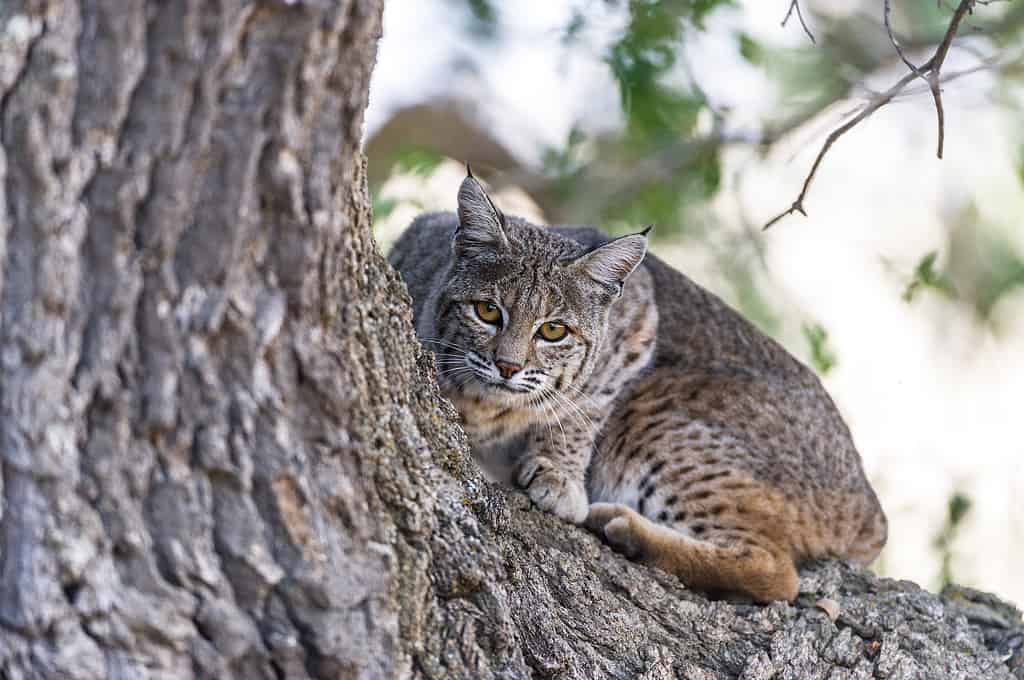
Bobcats are medium-sized wildcats with tufted ears and short tails.
©iStock.com/brentawp
Bobcats are medium-sized wildcats with tufted ears and short tails. They are active during twilight, using their keen senses to hunt small mammals, birds, and rabbits. If you see droppings along the trail, they may have been left behind by one of these wild cats.
5. Coral Snakes

One animal lurking atop Driskill Mountain is the venomous Eastern coral snake.
©Mark_Kostich/Shutterstock.com
Beware the colorful eastern coral snakes with their red, yellow, and black bands! These venomous snakes are active during the warmer months, hunting small reptiles and amphibians. Thankfully, snakes aren’t aggressive; just defensive. You’ll be safe if you stay out of their way.
6. Foxes
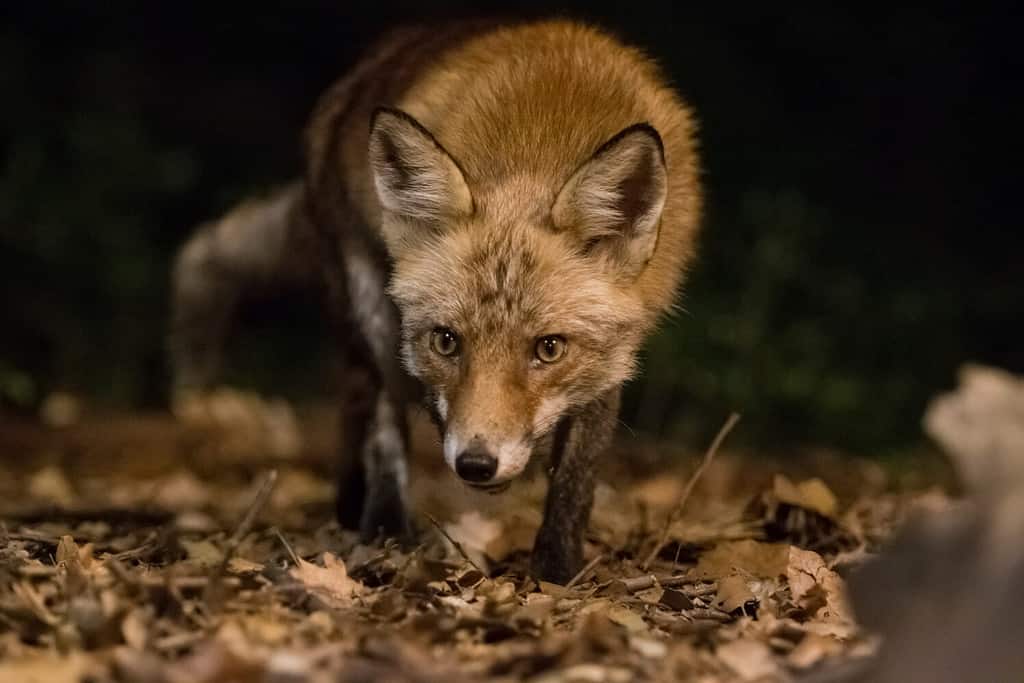
Louisiana is home to both red foxes (pictured above) and gray foxes.
©Daniel Rodriguez Garriga/Shutterstock.com
Louisiana is home to both red and gray foxes. Foxes are clever mammals with bushy tails and slender bodies. They are most active during dusk and dawn, skillfully hunting rodents, rabbits, and birds.
More Wildlife Around Driskill Mountain
7. Gopher Tortoise
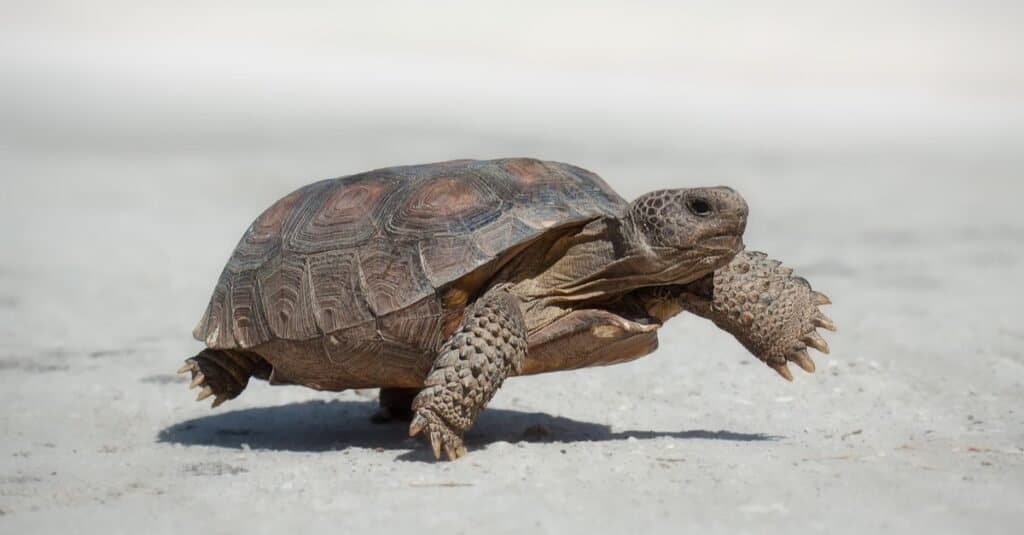
A gopher
tortoise
could be spotted on Driskill Mountain in Louisiana.
©Kristian Bell/Shutterstock.com
Spotting a large gopher tortoise will be the highlight of your hike! Gopher tortoises are terrestrial reptiles with sturdy builds and high-domed shells. They are active during the day, using their strong legs and claws to dig burrows that provide shelter for other animals.
8. Long-Tailed Weasel
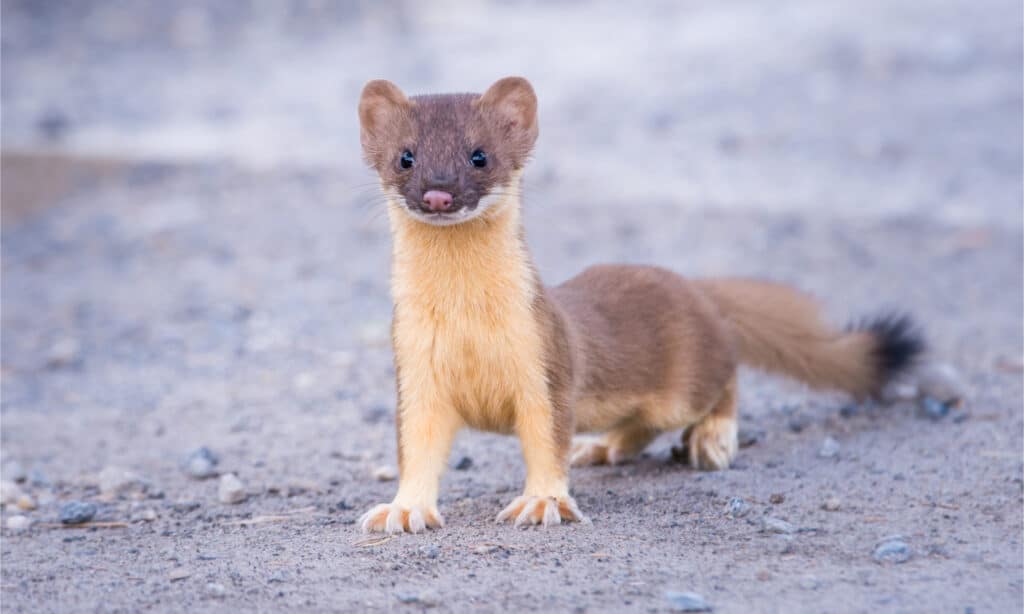
Long-tailed weasels are characterized by brown fur, a light-colored belly, and a long, black-tipped tail.
©Ghost Bear/Shutterstock.com
Long-tailed weasels are small carnivores with long, slender bodies and short legs. They have brown fur with a white underbelly and a distinctive, black-tipped tail. These agile hunters are active day and night, preying on small mammals and birds.
9. Northern Long-Eared Bat
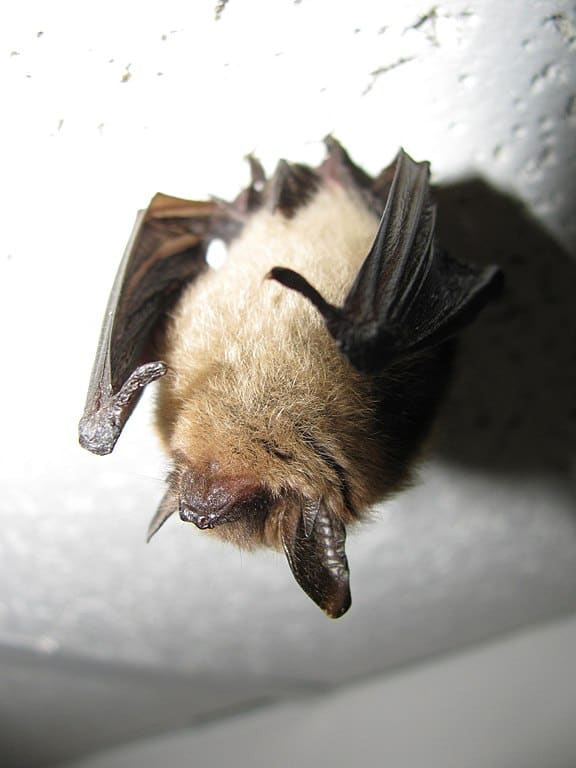
Northern long-eared bats are small, nocturnal creatures.
Northern long-eared bats are small bats with long ears and brown fur. They are nocturnal creatures, emerging at night to feed on insects using echolocation.
10. Quail

Quails forage for seeds and insects in grassy areas, and can be found in the mountains of Louisiana.
©iStock.com/Banu R
Quails are small ground-dwelling birds with plump bodies and distinctive markings. They are active during the day, foraging for seeds and insects in grassy areas and open fields.
11. Red-Tailed Hawks
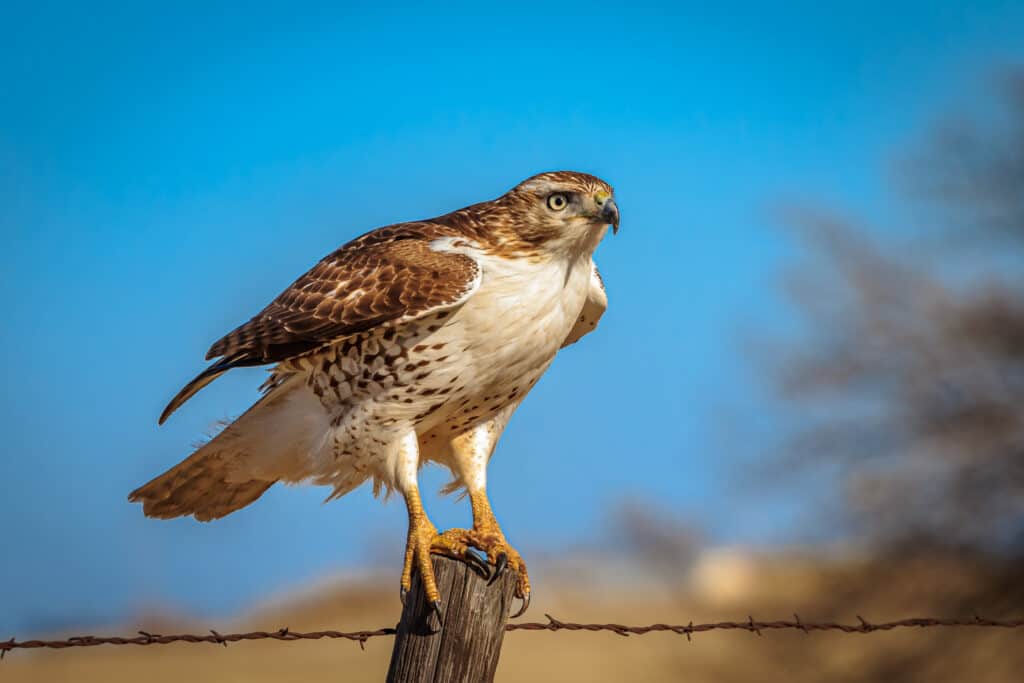
Red-tailed hawks mostly prey on live animals such as rodents and other small mammals.
©Richard G Smith/Shutterstock.com
Red-tailed hawks are large raptors with broad wings and a reddish-brown tail. They soar through the skies during the day, hunting small mammals and birds.
12. Squirrels

Squirrels rollick in the forests atop Driskill Mountain in Louisiana.
©Sam Robertshaw/Shutterstock.com
Agile and acrobatic, squirrels have bushy tails and come in various colors. They are active during the day, scurrying up and down trees and gathering nuts and seeds.
13. Spiders

Orb weaver
spiders are among the types of spiders you can encounter in Louisiana.
©Karthik Nayak Virajpet/Shutterstock.com
Driskill Mountain is known for having lots of impressive spiders. Some commonly encountered ones include the golden silk spider, black widow spider, wolf spider, and garden spider. Their appearances, behaviors, and habitats vary, but they all contribute to the balance of nature and help control insect populations.
14. Wild Turkeys
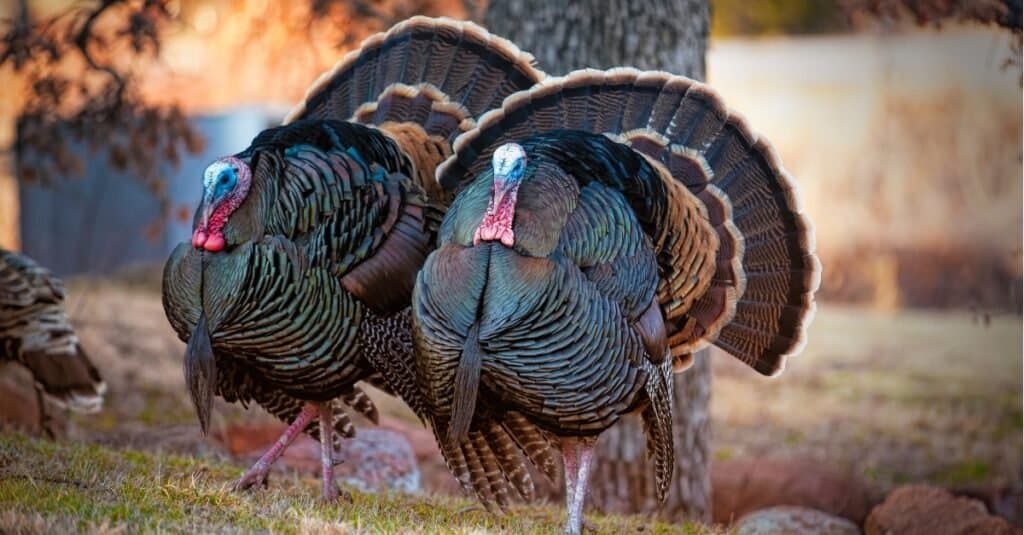
Wild turkeys roam in the mountains of Louisiana. A group of wild turkeys is called a “run.”
©iStock.com/davidsdodd
Wild turkeys are large birds with impressive plumage and fan-shaped tails. They are active daily, foraging for seeds, fruits, and insects on the ground. Fun fact; if you come across a group of turkeys, it’s called a “run.”
15. Wolves

There is known wolf activity in the mountains of Louisiana.
©Carol Heesen/Shutterstock.com
Wolves are social and intelligent predators with a powerful presence. While rare in the area, they are an iconic symbol of the wild. Talk to local guides to find out the latest safety tips to avoid hiking in areas known for wolf activity.
Different Types of Plants Around Driskill Mountain

This popular plant goes by many names and is found all around Driskill Mountain and in Northern Louisiana.
©iStock.com/Iseo Yang
Accompanying all of the animals running and flying around Driskill Mountain, you’ll find all sorts of lovely plants. Some plants only occur around Northern Louisiana, while others flourish throughout the entire state.
Here are some of the most common plants you’ll come across at Louisiana’s tallest mountain:
- Gaillardia pulchella
- Veratrum virginicum
- Samolus valerandi
Gaillardia Pulchella (Firewheel)
As you’re hiking around Louisiana’s tallest mountain, you’ll likely see Gaillardia pulchella. This popular plant goes by many names, like Indian blanket, firewheel, and rose-ring gaillardia. It’s found all around Driskill Mountain and in Northern Louisiana. It’s part of the Asteraceae family.
The leaves of Gaillardia pulchella are arranged alternately on the stem. They’re not too complicated either; they’re pinnate, which means they come in pairs along the stem and are simple, so no fancy leaflets. The leaves can be shaped oblong, lanceolate (like a lance), or oblanceolate (like a reversed lance).
This plant can be a forb (a non-woody plant) or a shrub. But what makes it special are the showy flowers! They come in super vibrant colors like orange, red, and yellow, showing off their beauty from May to September. Some of the animals that enjoy eating this plant include chickadees and warblers.
Veratrum Virginicum (Virginia Bunchflower)
Another plant around the mountain is Veratrum virginicum, also known as Virginia bunchflower. This plant is beautiful to see and lives in different counties in Louisiana. It belongs to the Liliaceae family, which is a fancy plant family.
The leaves of Veratrum virginicum alternately sit along the stem. They have smooth edges, so no jagged or tooth-like parts. These leaves are simple, meaning they have no smaller leaflets branching off.
Veratrum virginicum is what we call a forb, which means it’s a non-woody plant. This forb has lovely flowers that are usually white with six petals.
Samolus Valerandi (Brookweed)
Samolus veranda goes by names like seaside brookweed, water-pimpernel, and water-pimpernel. You can find this plant all over Louisiana. It’s part of the Primulaceae family.
The leaves of the Samolus veranda are arranged in a unique way. They can be found alternately along the stem but also form a basal rosette cluster. It’s like a little bunch of leaves huddled together at the base of the plant. Sheep and horses are known for munching on the spinach-like leaves of this plant.
When Samolus Valerandi blooms, it puts on a beautiful show. The flowers are lovely white and usually have five pretty petals. This plant is actually native to Mount Driskill and is a tough one too. It can choose to live life as a biennial, completing its life cycle in two years, or it can stick around longer as a perennial, living for multiple years.
Variety of Trees Around Louisiana’s Tallest Mountain
Now, let’s shift our focus to the magnificent trees that grace Louisiana’s tallest mountain. These towering beauties add a touch of grandeur to the scenery. Here are a few noteworthy tree species you might encounter:
Baldcypress (Deciduous) – A bald cypress tree can reach heights of 100 feet with a spread of 25-50 feet. It initially grows rapidly and then at a more moderate pace. Baldcypress thrives in moist to wet environments and is well-known for its distinctive buttressed trunk and graceful, feathery foliage.
Eastern Red Cedar (Evergreen) – Stands at around 50 feet tall with a spread of 30 feet. Eastern Red Cedar is an evergreen tree that grows at a slow to moderate rate. It can tolerate a range of moisture conditions, from moist to dry. With its dense foliage and reddish-brown bark, it adds year-round greenery to the landscape.
Live Oak (Evergreen) – Live Oak is a magnificent evergreen tree known for its wide-spreading branches and grand appearance. It can reach heights of 75 feet and spread over 100 feet. Initially growing at a moderate rate, it eventually slows down. Live Oak can adapt to a variety of moisture conditions, from dry to moist.
Flowering Dogwood (Deciduous) – With its iconic white or pink flowers, the Flowering Dogwood is a charming deciduous tree. It typically grows up to 25-30 feet tall with a spread of 20 feet. Its growth rate is moderate, and it prefers moist to dry environments. Flowering Dogwood is often admired for its vibrant spring blooms.
Green Ash (Deciduous) – Green Ash is a deciduous tree that can reach heights of 60 feet with a spread of 50 feet. It has a rapid growth rate and thrives in moist conditions. The tree’s leaves turn a vibrant yellow in the fall, adding a splash of color to the landscape.
Animals That Live in the Trees
What animals live in the trees atop Louisiana’s tallest mountain? Baldcypress trees serve as nesting sites and roosting spots for various bird species. Wood ducks, herons, egrets, and owls nest in the cavities or branches of these trees. The dense foliage of bald cypress provides cover and protection for many bird species.
The trees around the mountain are also home to raccoons, squirrels, and bats. All of these mammals can use the tree’s hollow cavities as shelter or den sites. Eastern red cedar and flowering dogwood also support a rich diversity of insects and invertebrates. These include various beetles, butterflies, dragonflies, and spiders.
The tree’s decaying wood and leaf litter provide habitat and food sources for many decomposers and detritivores. Detritivores are like nature’s cleanup crew! Their job is to eat something called detritus, which is basically dead plant or animal material. This could be things like fallen leaves, dead insects, or even poop.
What Other Hikers Say About Driskill Mountain
Planning to hike Louisiana’s tallest mountain? Let’s take a look at what people have to say about their experiences hiking Driskill Mountain, so you can have the best trip!
Review 1: “Driskill Mountain offers an easy hike along a well-maintained road and path. Parking at the church entrance is convenient, and hikers of all levels can enjoy this hike easily. Remember to check out the high point marker and monument at the top!”
Review 2: “While the elevation may not be much, the hike at Driskill Mountain is still a unique experience. Respecting the landowners who graciously allow others to enjoy this hike is important. Remember to be mindful of their property during your visit.”
Review 3: “If you’re looking for a quick hike, the total duration at Driskill Mountain can be less than 50 minutes, including time spent at the top. The terrain is easy, with only some elevation gain. It’s even dog-friendly, so your furry friend can join you on the adventure!”
Remember, if you’re feeling more adventurous, harder-marked paths are available for those seeking a bigger challenge.
Best Time to Visit Louisiana’s Tallest Mountain
Spring, in particular, is an excellent time to hike Louisiana’s tallest mountain, Driskill Mountain. The trail also showcases the beautiful blooming of wild azalea flowers. Many hikers recommend visiting in March to witness the stunning display of wild azaleas in the Castor Creek Scenic Area, where the flowers fill the hollows between the hills.
Check Heat Index
Check the heat index and weather conditions before embarking on your hike. Louisiana can get extremely hot, especially during the summer when temperatures can surpass 100 degrees Fahrenheit. It’s essential to avoid hiking on scorching days to prevent heat-related issues.
Drink Water
Hydration is key when hiking in Louisiana. Be sure to bring plenty of water to stay fully hydrated. Louisiana’s heat and humidity can cause excessive sweating, making it challenging to replenish fluids.
Final Thoughts
Now you know all about the plants and animals living around Louisiana’s tallest mountain. During your hike, you might spot big brown bats, black snakes, black bears, bobcats, foxes, and even wolves. The area is also abundant with amazing birds like red-tailed hawks and wild turkeys. Just remember to admire the venomous coral snakes from a safe distance.
Before heading out, check the heat index and plan your hike accordingly. Louisiana can get very hot, especially in the summer. Stay hydrated and take breaks during the hottest part of the day. And of course, don’t forget your camera!
Summary of 15 Animals Living Atop Louisiana’s Tallest Mountain
| Animal | |
|---|---|
| 1 | Big Brown Bat |
| 2 | Black Snake |
| 3 | Black Bear |
| 4 | Bobcat |
| 5 | Coral Snake |
| 6 | Fox |
| 7 | Gopher Tortoise |
| 8 | Long Tailed Weasel |
| 9 | Northern Long-Eared Bat |
| 10 | Quail |
| 11 | Red-Tailed Hawk |
| 12 | Squirrel |
| 13 | Spider |
| 14 | Eastern Wild Turkey |
| 15 | Wolf |
Thank you for reading! Have some feedback for us? Contact the AZ Animals editorial team.

